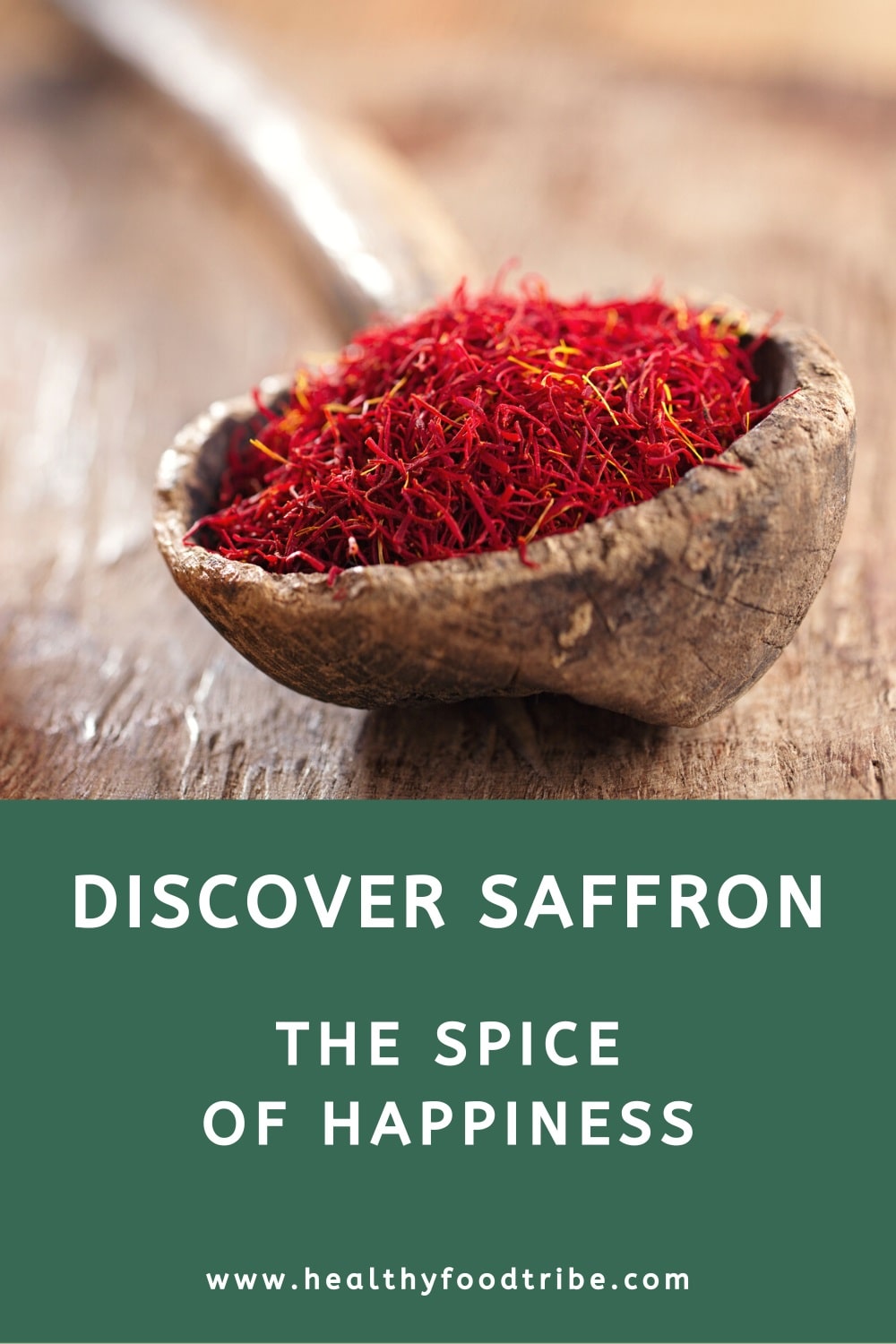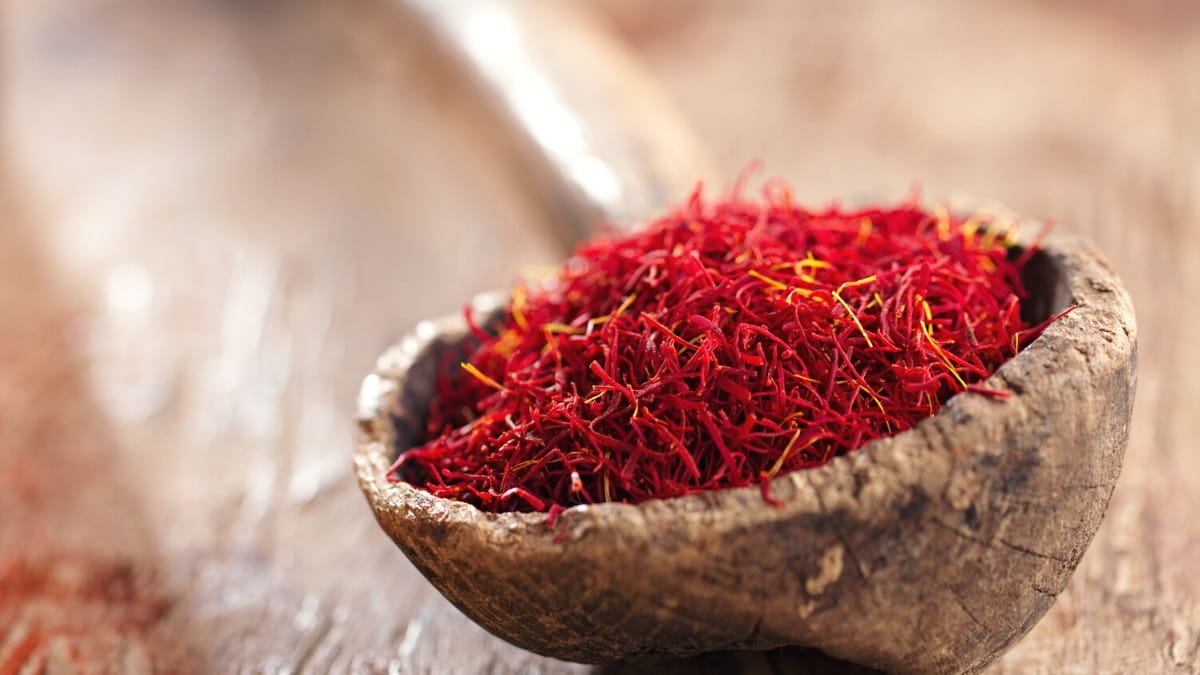Last updated: November 17, 2023
Discover saffron, also known as the spice of happiness and the most expensive spice in the world. What makes the saffron flower so special?
In this article, I am going to share with you how I discovered Saffron, also known as the spice of happiness, and often referred to as the most expensive spice available anywhere in the world.
There’s so much more to saffron than just its unique taste, pretty looks, and high price tag, so let’s go on a little saffron discovery tour with me!
Quick navigation:
What Is Saffron?
Saffron is a unique spice derived from the flower of Crocus sativus, also referred to as the saffron crocus. The spice consists of the dried stigmas (or threads) of the flower, which are meticulously hand-harvested.
Each flower produces only three stigmas, making saffron one of the most labor-intensive and expensive spices in the world.
Saffron threads are primarily red. This deep red color is a characteristic feature of high-quality saffron. However, when saffron is used in cooking, it imparts a rich golden-yellow hue to dishes.
This color transformation occurs as the spice releases its natural pigments, primarily crocin, into the food during the cooking process.
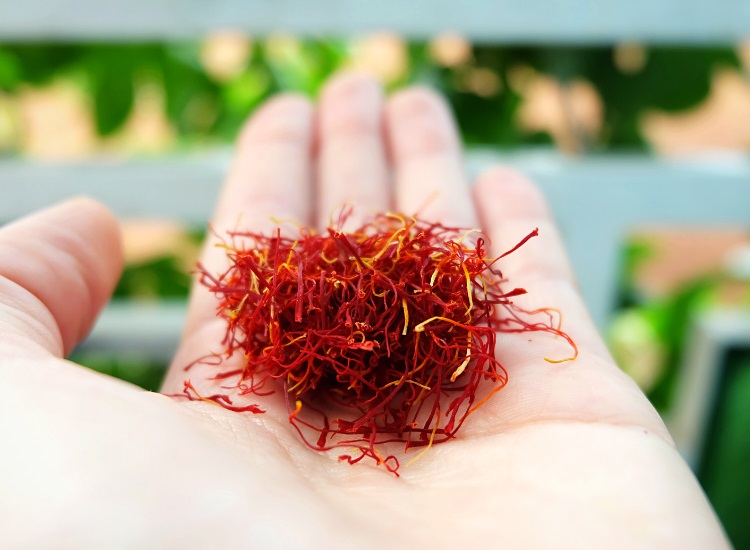
The distinct flavor and aroma of saffron are typically described as slightly sweet, floral, and earthy.
It’s a staple in various cuisines worldwide, notably in Persian, Spanish, Indian, and Italian cooking. Saffron is used in famous dishes like Spanish paella, Italian risotto alla milanese, and Indian biryanis.
In addition to its culinary uses, saffron has been valued in traditional medicine for its potential benefits. However, due to its high cost, it’s often sold in very small quantities and used sparingly in cooking.
The History of Saffron
To learn more about saffron, it’s worth doing a deep dive into its intriguing history. As such, let me tell you a little story about how my Spanish friend Xavier introduced me to the spice saffron.
“We will plant our saffron flags in Delhi, the heart of the Mughal empire!” This is the hero of the movie we are watching.
“Saffron? Isn’t saffron something you eat?” That’s me, being a little ignorant.
Rain is thumping against the window panes. A majestic war scene is developing on Xavier’s home theatre screen. Our Spanish friend has invited us to his place to make the most of a dull, gray, rainy Sunday.
Xavier is a historian and a gourmet with a particular penchant for ancient Asian civilizations. He has promised us a double surprise.
So far, he is keeping his word. I had no experience with Indian cinema. The epic tale of war and love that is unfolding before our eyes is really quite breathtaking. Lavish visuals and cliff-hanging style drama, Bollywood at its best.

But what’s saffron got to do with it?
“You are right, saffron is something you eat. You are going to get it for dinner,” Xavier laughs. “Beware, you risk getting addicted to it!”
The scent coming from the kitchen towards the end of the movie is proof that he is not joking. My attention is torn between the drama happening on the screen and the dining room behind our backs.
“Xavier, you are not going to drug us, are you?”
“Well… no!” he chuckles. “But there is actually scientific evidence that saffron may have some psychotropic effects!”
From India to Spain
A triumph of orange shrimps, blue mussels, red bell peppers, and green peas, on top of a mound of golden rice. This is what appears on the dinner table in front of my mesmerized eyes.
I am still in India with the warrior Bajirao, but the glorious paella makes me wake up in Spain by the time I walk to the table.
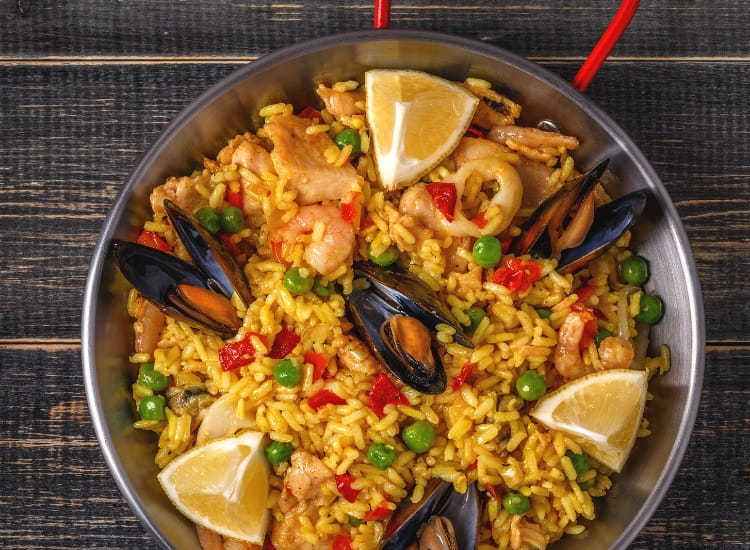
At this point, I have realized that saffron has to do with yellow. A sacred color, the symbol of humility and sacrifice.
But… what is saffron?
“A flower.”
“A yellow flower?”
“No. A violet flower. With a heart of fire.”
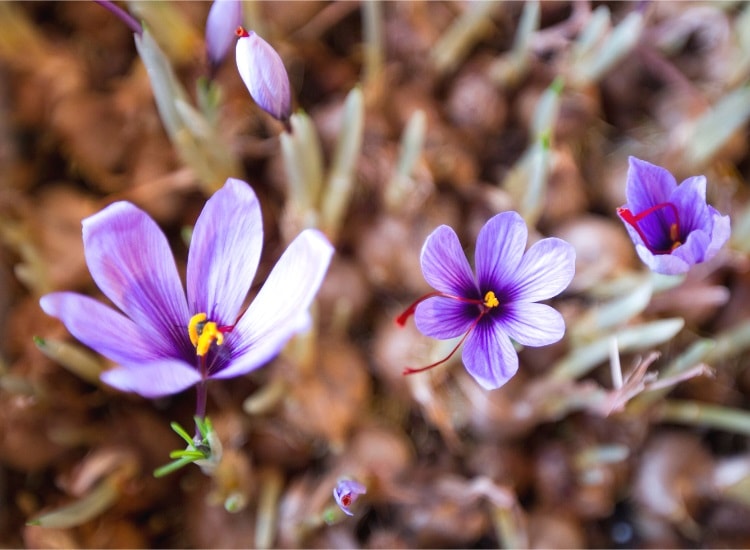
Our host produces a small glass jar closed with a cork stopper. Slender, fiery red threads are visible inside.
Saffrons Stigmas
“These are the stigmas, the female reproductive organs, of the Crocus Sativus. Saffron, the spice of happiness. Azafran, as we call it in Spanish. We owe it to the Moors, the Arabs who conquered Spain in the Middle Ages. They brought it along and called it az-zafaran.”
The jar is very light. I turn it around to read from the label: 1 gram… and 20$! What???
“There are 200 flowers in that little jar. That is, their stigma, each flower has only three of them. Flowers bloom only for about ten days in late autumn.”
“Many hands picked those flowers from the fields in La Mancha, the homeland of Don Quixote. And more hands plucked the threads gently from the flowers, then toasted them carefully above a fire to dry them,” Xavier explains. “Saffron is a labor of love. And the most expensive spice in the world.”
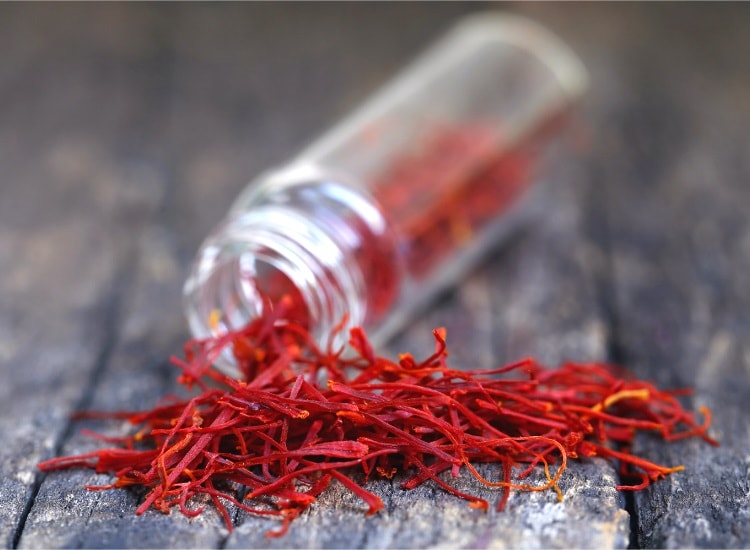
Unexpectedly, my friend Sarah, another avid foodie, speaks out: “No way! I am not eating saffron again. I prepared a “risotto alla milanese” at home last month, and we threw it all away. It tasted metallic”.
“Then you were scammed. You bought some counterfeit saffron. There are lots of fakes around. Just taste mine”.
Xavier is right. The gang around the table falls silent for quite a while. All you can hear are sighs.
From Spain to Iran
Paella is very nutritious, so there is no need for a second course. But here comes a golden pudding for dessert. Something unusual and very special.
I cannot recognize what is in it, apart from the garnish of nuts, cinnamon, and rose petals. Our host is grinning and encouraging us to guess, but until he tells us, we cannot make out that the mysterious substance is rice.
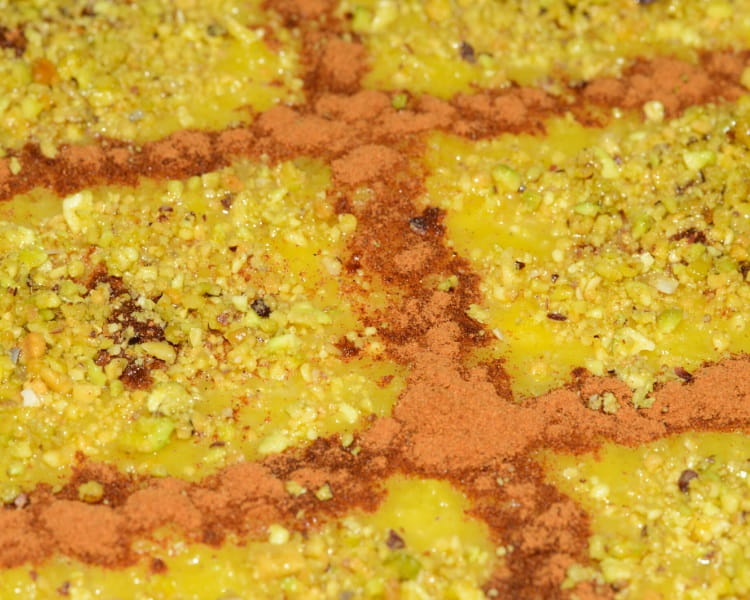
Sholezard, or Sholeh Zard, is the Farsi (Persian) name of this traditional Iranian saffron rice pudding dessert recipe, our host explains.
Not by chance: Iran produces ninety percent of all the saffron sold in the world. He shows us another little glass jar with a mysterious script printed on the label.
We find out that Xavier has a whole collection of high-quality saffron from all over the world. Saffron from Kashmir. Saffron from Italy. Saffron from France. Saffron from Morocco. Saffron from Greece. And many more.
Where Does Saffron Really Come From?
This question has never been answered and probably never will. Saffron has been around for millennia.
They found it painted in the frescoes of Minoan palaces on the Greek Islands from the Bronze Age. But also in prehistoric paintings in caves in Iraq that date back 50.000 years.
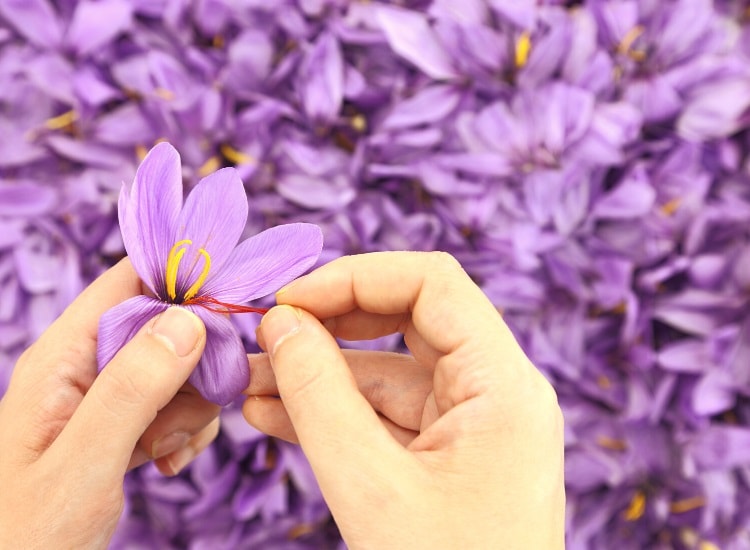
Sumerian priests mixed it in their magic potions, and Cleopatra used it as an aphrodisiac. The Mughal conquerors took it to India, where it became popular as a spice and as a dye for clothes.
Human beings were already traveling and trading thousands of years ago. Who was the first to grow saffron, and who brought it to whom? It is an open question.
What is certain is that all saffron-producing regions claim that theirs is the best in the world, and that is fine.
What Does Saffron Taste Like?
After that epic dinner, I plunged into an intensive reading session of all things saffron. I found that it is not only me who has problems in describing exactly what it tastes like.
The Iranian saffron we had in the dessert was more flowery with a reminiscence of honey. The Spanish one in the paella was stronger, with a slightly bitter aftertaste.
But the truth is that it is hardly possible to describe the taste of saffron. So unmistakable and yet difficult to define. You can only try it.
International Dishes With Saffron
There are so many traditional rice dishes with saffron in different parts of the world, because rice is neutral and brings out the spice’s nuances at its best.
Biryani rice with chicken is a favorite staple in countries like India and Pakistan. The Italian risotto alla milanese only uses a little bone marrow to enhance the taste, and Parmesan, obviously.
Stews benefit from saffron too, and not only in meat recipes. The trademark specialty in Marseille, France, is bouillabaisse, a famous fish stew, which is unthinkable without saffron.
Saffron is also a favorite with cakes and ice creams. If you have some spare time, here is a BBC vintage documentary video that shows how traditional saffron buns are made in Cornwall.
How to Use Saffron?
The red threads work their magic in minimal quantities: 3 or 4 per person are enough to change the aroma of a dish in unspeakable ways.
There are two main ways to add saffron to your recipes:
-
Method 1: Blooming:
Put your saffron threads in a bowl with some warm water or milk, depending on the recipe. Let them infuse for 15-20 minutes, and you will see it turn into a beautiful yellow tea. Add the golden liquid to your food, so the flavor and color will spread evenly. -
Method 2: Make a powder:
Crush your saffron in a mortar. The powder will be much easier to mix in your recipe than the whole threads. You can always crumble the stigmas between your fingers and spread the fragments like salt, if you don’t have a mortar.
Remember that saffron likes it slow. This special spice takes its time to release its color and aroma. Unlike salt and pepper, its effect is not immediate.
Recipes that boil or stew longer make the most out of saffron.
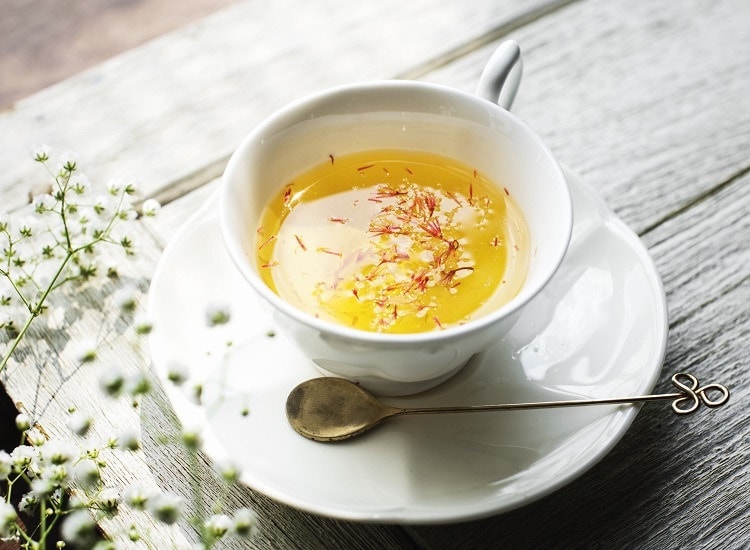
How to Recognize Fake Saffron?
Impressed by Xavier’s collection, I did some research. It left me totally confused by the enormous differences in price between saffron products on offer around the world.
The most expensive reference I found was from this article in The Telegraph which mentions that you can buy a 0.2g packet from Fortnum & Mason for £15, which amounts to £7,500 for 100g.
Wow!
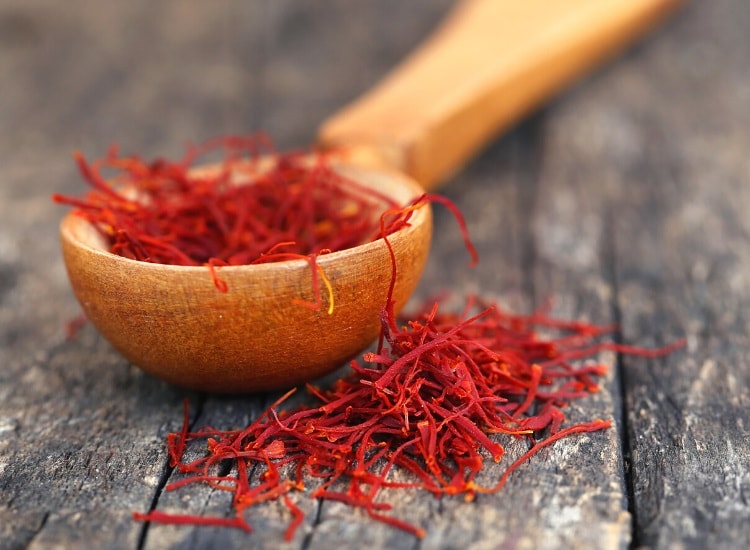
Then I learned that the super-extra-top quality saffron discards the white and yellow part of the stigma and keeps only the deep red one, the most aromatic. Color and flavor are stellar, but the quantity of material is even more reduced, and the price shoots through the ceiling.
The Iranians call this extra quality Sargol or Negin.
In any case, it’s big business. No wonder there are so many fakes around. I put together this little table to help you avoid a rip-off if you plan to shop for saffron.
| Criteria | Red flags | The explanation |
|---|---|---|
| Price: how much is too low? | About $10 and less per gram. | Good quality saffron will not sell for less than $15. Top quality can be more than $65 per gram. |
| Format: powder or threads? | Powder | Powder is easier to fake by adding turmeric or other spices. |
| Texture | Mushy | Scammers store the product in damp conditions to earn more on weight. Quality saffron threads should be dry. |
| Shape and consistency | Straight threads. Deforms/dissolves in warm water. | Real saffron threads have the shape of a trumpet, with a narrower base and a wider tip. Counterfeit can be corn silk or other materials, artificially colored. |
| Color | Threads with a lot of yellow and white. | High-quality saffron keeps only the red part. If the color is fake, threads put in warm water will immediately discolor and release an orange/red die. True saffron slowly releases a golden yellow color. |
| Smell | Hardly any scent. | True saffron smells sweet and husky, often described as a mixture of honey and hay scent. |
| Taste | If it tastes sweetish, metallic, or “like plastic”, it’s fake. | Real saffron has a slightly bitter taste, a little astringent. |
I also found this video shot in a saffron shop in India, useful to learn what a fake looks like.
And here is a similar test with water, demonstrated by an Australian importer of Kashmiri and Iranian saffron.
Potential Benefits of Saffron
The nutritional profile of saffron is not really relevant since you use the red gold in fractions of a gram. It gives you flavor, not nourishment.
And yet, I was curious, so I looked it up all the same.
The FoodData Central of the U.S. Department of Agriculture has a helpful web search function. If you search for saffron there, you will discover something interesting. The query returns not only saffron, the spice, but also a long series of preparations that make use of it. They are all marked “Branded”.
There is a lot of fancy stuff listed, like saffron risotto, saffron rice, saffron threads, saffron chai Spice plant-based gelato (ice cream!), and dozens more.
At the moment, there are more than 140 ready-to-eat products that use saffron. With all their nutritional values. Nice.
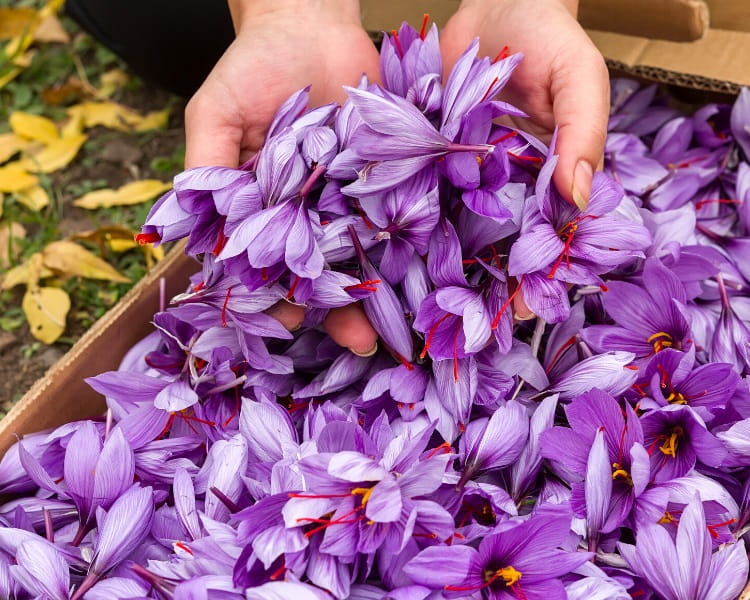
The list of scientific studies on the medicinal properties of saffron is quite impressive. Here are some insights:
- Antidepressant effects:
The properties of saffron have been tested both for the treatment of mild and moderate depression, and to support other therapies in depressive disorder. And this research carried out in Australia demonstrates the relationship between saffron and depression. - Antioxidant properties and protection against neuronal damage:
Crocin, the pigment that gives saffron its color, has also shown potential to improve learning and memory. It could protect brain cells. Together with the other main bioactive saffron constituents, crocetin and saffranal, they appear to be effective against neurodegenerative diseases. - Treatment of digestive system disorders:
The potential therapeutic properties of saffron have been studied in connection to various diseases such as hepatotoxicity, fatty liver, hyperlipidemia, peptic ulcer, ulcerative colitis, and diabetes. - Antiviral effects:
Saffron and its compounds have been used to treat different pathological conditions, with the results suggesting antiviral activities for saffron extract and its major ingredients.
Conclusion
So, do I think saffron is worth the money?
Yes, I do. I still feel the taste of that dinner. And I plan to do some saffron shopping too.
The price tag is significant, for sure, but let’s face it: none of us will ever buy a pound of saffron. Not even 100 grams. A one-gram vial contains dozens of threads, and since you use only a few at a time, a portion of yellow saffron rice is not crazily expensive.
Above all, the whole story is simply too fascinating for me. Exotic and rich, like the taste of saffron.
Also read:
